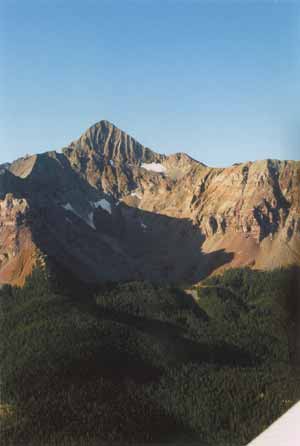|
|

| Mountain Pass AWOS |
The Colorado Aeronautical Board and the Colorado Department of Transportation's Division of Aeronautics have taken an innovative approach to improving air travel through the Continental Divide, one of the nation's most volatile flying environments. Combining creativity and partnerships, these two groups have implemented a new system that will greatly reduce the risks of flying through Colorado's mountains.
Automated Weather Observing Systems (AWOS), designed for airports, are being installed in 12 of the state's critical mountain passes. These systems provide continuous real-time weather reports including wind direction, wind speed, temperature, visibility, precipitation, storm proximity and density altitude. This information will help pilots make critical decisions about whether or not to travel.
Flying through Colorado mountain passes at altitudes of 10,000 feet or higher presents challenges for both general aviation aircraft and even the most experienced pilots. When this is coupled with Colorado's unpredictable weather conditions, it can present a formula for disaster.
Typically pilots have been forced to guess what weather conditions were in the passes, based on the conditions on each side. However, as pilots and highway users both know, weather conditions outside a pass through the Rocky Mountains can be vastly different from what the weather is like inside the pass. Historically, pilots have relied on weather reports generated far away from the mountain passes they would be flying through. While the reports did help, they weren't always accurate. On average, 17 people a year die in general aviation air crashes in Colorado's Rocky Mountains.
The Colorado Mountain Pass AWOS program uses an existing, highly reliable technology that is being used at unmanned airports. The system provides continuous reports every minute. It meets all FAA and FCC regulations and is self-monitoring so that if data is missing or questionable, it will report data as missing until the error is corrected. The data is archived every 20 minutes for up to 80 days, providing valuable information to investigators researching an air crash.
With input from the Colorado Pilots Association, the National Transportation Safety Board, individual pilots and others, 12 mountain passes were selected for the AWOS installation: Corona Pass, Vail Pass (Copper Mountain), Monument Hill, Monarch Pass, La Veta Pass, Wolf Creek Pass, Glenwood Springs (Sunlight Ridge), Kremmling, Cameron Pass, Wilkerson Pass, Cottonwood Pass, and Saguache. Each location was chosen for the volume of air traffic passing through it.
After selecting the AWOS sites, then came the task of choosing contractors to actually install the systems. CDOT aeronautics engineer T.K. Gwin packed bidders into his suburban and spent days driving and hiking to each site-at altitudes of up to 13,000 feet. The contract was awarded to Airport Systems Maintenance, Inc.
Making the job even more difficult was the requirement for ground electrical power and telephone connections. Each location presented unique challenges and opportunities. For example, to get clearance for the Corona Pass installation, Gwin had to register as a research scientist and contractors had to hand carry equipment up a dirt trail at more than 12,000 feet. At the Wolf Creek Pass site, the team had to dig through five feet of snow to lay footings for the system. Special arrangements had to be made with landowners and managers including the U.S. Forest Service, the University of Colorado's Niwot Ridge Alpine Research Station near Corona Pass and several ski resorts.
"This project is really a model for what can be accomplished by public/private partnerships. Ski resort workers, legislators, CDOT staff and even engineers from Vaisala, the manufacturing company, all worked together," said CDOT Executive Director Tom Norton. "It took tremendous cooperation and vision for this project to be a success and if it saves just one life, it will have proven to be so."
Governor Bill Owens was a big supporter of the project and his interest helped propel it through the 2000 legislative session. The Legislature passed House Bill 1069 providing $500,000 of General Fund dollars. That, in addition to $300,000 from the Colorado Aeronautical Board and $250,000 from the Legislature in 2001, was enough to fund the $1.2 million project, which completes 10 systems.
"This project will provide a seamless weather reporting grid for pilots, something that was not possible before," said Governor Bill Owens. "The information will be available through a web site, telephone, aviation radio frequencies and preflight briefings. Six of the installations are up and running with six more planned for 2002."
|
The six mountain pass AWOS systems
that have been installed are:
Corona Pass
134.175 - (303) 258-3052
Vail Pass (Copper Mtn.)
124.175 - (970) 968-1715
Monument Hill
134.375 - (303) 648-3479
Monarch Pass
120.0 - (719) 539-4436
La Veta Pass
119.925 - (719) 587-3123
Wolf Creek Pass
121.125 - (970) 264-2180
|
 |
|
Click here to return to the beginning of this article.  |
|